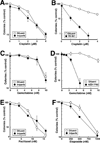Failure of iniparib to inhibit poly(ADP-Ribose) polymerase in vitro
- PMID: 22291137
- PMCID: PMC3306513
- DOI: 10.1158/1078-0432.CCR-11-2890
Failure of iniparib to inhibit poly(ADP-Ribose) polymerase in vitro
Abstract
Purpose: Poly(ADP-ribose) polymerase (PARP) inhibitors are undergoing extensive clinical testing for their single-agent activity in homologous recombination (HR)-deficient tumors and ability to enhance the action of certain DNA-damaging agents. Compared with other PARP inhibitors in development, iniparib (4-iodo-3-nitrobenzamide) is notable for its simple structure and the reported ability of its intracellular metabolite 4-iodo-3-nitrosobenzamide to covalently inhibit PARP1 under cell-free conditions. The present preclinical studies were conducted to compare the actions iniparib with the more extensively characterized PARP inhibitors olaparib and veliparib.
Experimental design: The abilities of iniparib, olaparib, and veliparib to (i) selectively induce apoptosis or inhibit colony formation in HR-deficient cell lines, (ii) selectively sensitize HR-proficient cells to topoisomerase I poisons, and (iii) inhibit formation of poly(ADP-ribose) polymer (pADPr) in intact cells were compared.
Results: Consistent with earlier reports, olaparib and veliparib selectively induced apoptosis and inhibited colony formation in cells lacking BRCA2 or ATM. Moreover, like earlier generation PARP inhibitors, olaparib and veliparib sensitized cells to the topoisomerase I poisons camptothecin and topotecan. Finally, olaparib and veliparib inhibited formation of pADPr in intact cells. In contrast, iniparib exhibited little or no ability to selectively kill HR-deficient cells, sensitize cells to topoisomerase I poisons, or inhibit pADPr formation in situ. In further experiments, iniparib also failed to sensitize cells to cisplatin, gemcitabine, or paclitaxel.
Conclusions: While iniparib kills normal and neoplastic cells at high (>40 μmol/L) concentrations, its effects are unlikely to reflect PARP inhibition and should not be used to guide decisions about other PARP inhibitors.
Conflict of interest statement
Figures






References
-
- Kaelin WG., Jr The concept of synthetic lethality in the context of anticancer therapy. Nat Rev Cancer. 2005;5:689–698. - PubMed
-
- Rehman FL, Lord CJ, Ashworth A. Synthetic lethal approaches to breast cancer therapy. Nat Rev Clin Oncol. 2010;7:718–724. - PubMed
-
- Farmer H, McCabe N, Lord CJ, Tutt AN, Johnson DA, Richardson TB, et al. Targeting the DNA repair defect in BRCA mutant cells as a therapeutic strategy. Nature. 2005;434:917–921. - PubMed
-
- Bryant HE, Schultz N, Thomas HD, Parker KM, Flower D, Lopez E, et al. Specific killing of BRCA2-deficient tumours with inhibitors of poly(ADP-ribose) polymerase. Nature. 2005;434:913–917. - PubMed
-
- McCabe N, Turner NC, Lord CJ, Kluzek K, Bialkowska A, Swift S, et al. Deficiency in the repair of DNA damage by homologous recombination and sensitivity to poly(ADP-ribose) polymerase inhibition. Cancer Res. 2006;66:8109–8115. - PubMed
Publication types
MeSH terms
Substances
Grants and funding
LinkOut - more resources
Full Text Sources
Other Literature Sources
Medical
Research Materials
Miscellaneous

